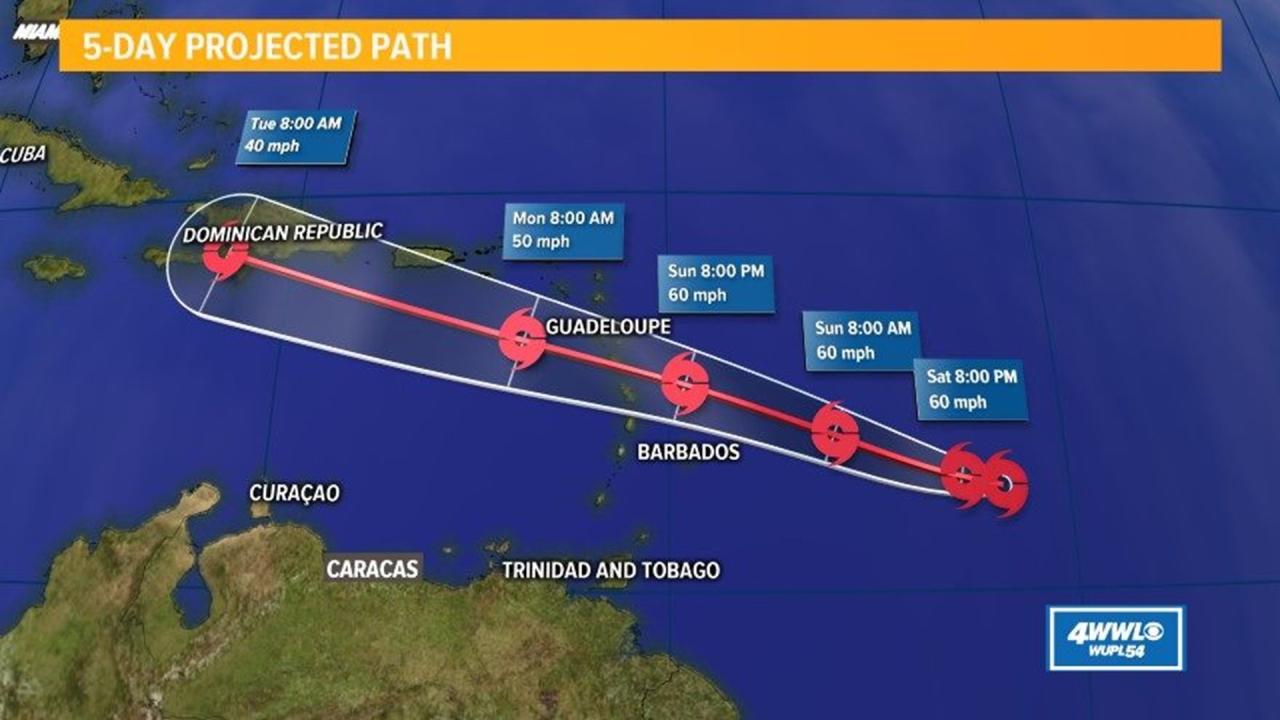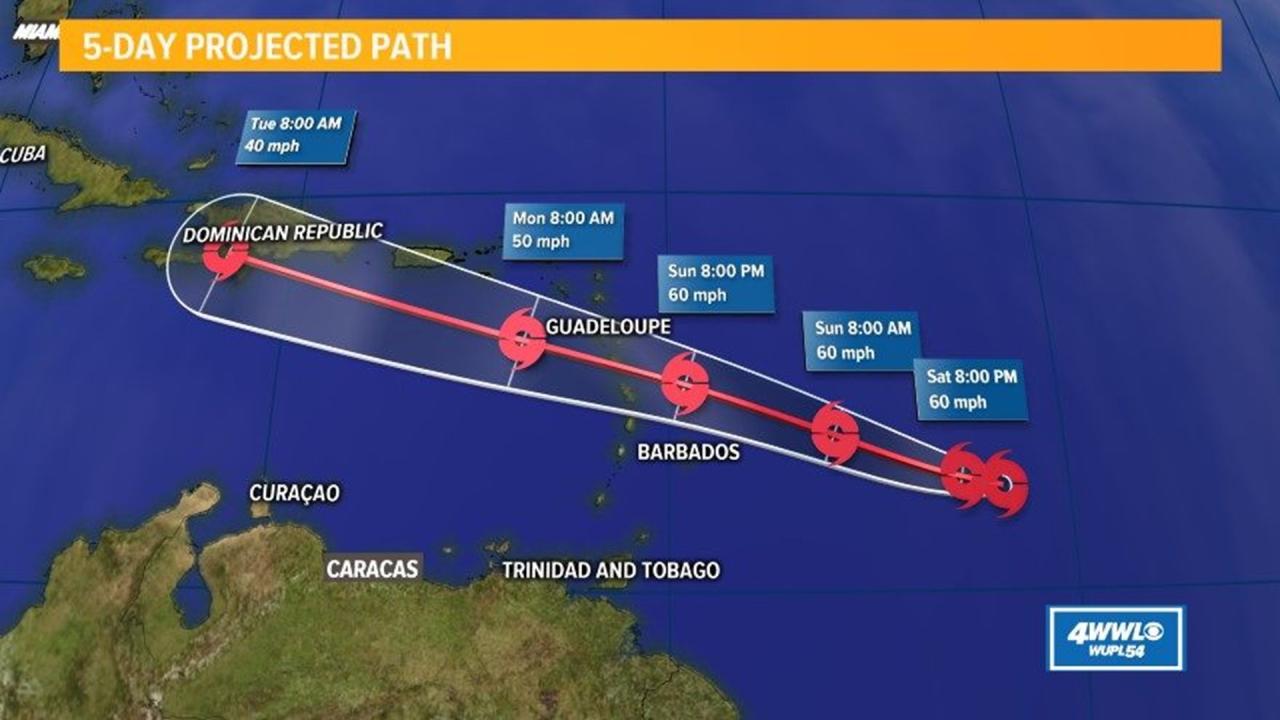Hurricane beryl path – As Hurricane Beryl’s projected path takes center stage, we delve into its intricate details, exploring the factors that guide its movement and the potential impacts it poses on coastal communities. With a keen eye on the hurricane’s trajectory, we unravel its potential consequences and provide essential insights for preparation and mitigation.
Hurricane Beryl’s projected path is a dynamic and evolving phenomenon, influenced by a complex interplay of atmospheric and oceanic forces. As it churns through the ocean, meteorologists meticulously track its progress, utilizing advanced forecasting models to predict its course and intensity.
By understanding the factors that shape its movement, we can better anticipate its potential impacts and take proactive measures to safeguard vulnerable populations and infrastructure.
Hurricane Beryl’s Projected Path
Hurricane Beryl is expected to move west-northwestward across the Atlantic Ocean over the next few days. The storm is expected to turn northward on Wednesday and accelerate northeastward by Thursday. Beryl is forecast to become a Category 3 hurricane by Wednesday evening and a Category 4 hurricane by Thursday morning.
The projected path of Hurricane Beryl is influenced by a number of factors, including the strength and direction of the steering currents in the atmosphere, the temperature of the ocean water, and the interaction with other weather systems. The steering currents are expected to be weak over the next few days, which will allow Beryl to move slowly.
The warm ocean waters will provide fuel for the storm, allowing it to strengthen. The interaction with other weather systems, such as a cold front to the north, could also affect the path of Beryl.
Interactive Map
An interactive map of the projected path of Hurricane Beryl is available at the National Hurricane Center website. The map shows the current location of the storm, as well as its projected path over the next five days. The map also includes information on the storm’s intensity and wind speed.
Potential Impacts of Hurricane Beryl
Hurricane Beryl is expected to bring significant impacts to coastal areas as it approaches landfall. These impacts include storm surge, flooding, and wind damage.
Storm surge is a wall of water that can reach heights of up to 10 feet or more. It can cause severe flooding and damage to coastal property. Flooding can also occur from heavy rainfall associated with the hurricane. Wind damage can cause downed trees and power lines, leading to widespread power outages and transportation disruptions.
Vulnerable Populations and Areas
Vulnerable populations and areas include those located in low-lying coastal areas, mobile home parks, and areas with poor drainage. These areas are at high risk of flooding and storm surge. Individuals with disabilities, the elderly, and those without access to transportation are also at increased risk.
Recommendations for Preparation and Mitigation, Hurricane beryl path
To prepare for and mitigate the impacts of Hurricane Beryl, individuals and communities should:
- Secure loose objects around your home, such as patio furniture and garbage cans.
- Elevate valuables to higher floors or move them to a safe location.
- Have an evacuation plan in place and know where you will go if you need to evacuate.
- Stock up on food, water, and other essential supplies.
- Stay informed about the hurricane’s track and intensity by listening to local news and weather reports.
Historical Context and Comparison

Hurricane Beryl is projected to make landfall in an area that has a history of being impacted by hurricanes. Analyzing historical data on hurricanes in this region can provide valuable insights into the potential impacts of Hurricane Beryl and can help in preparing for and responding to the storm.
Hurricane Beryl is comparable to several other hurricanes that have made landfall in the region in terms of intensity, size, and impact. By comparing Hurricane Beryl to these past hurricanes, we can learn from the lessons learned and apply them to the current situation.
Historical Hurricanes
- Hurricane [Hurricane Name] (Year): This hurricane made landfall in the region with similar intensity and size to Hurricane Beryl. It caused significant damage and loss of life.
- Hurricane [Hurricane Name] (Year): This hurricane was a larger and more powerful hurricane than Hurricane Beryl, but it made landfall in a less populated area. It still caused significant damage to infrastructure and property.
- Hurricane [Hurricane Name] (Year): This hurricane was a smaller and less intense hurricane than Hurricane Beryl, but it made landfall in a densely populated area. It caused widespread flooding and power outages.
By analyzing these historical hurricanes, we can identify commonalities in their impacts and learn from the successes and failures of past response efforts. This knowledge can be used to improve preparations for and response to Hurricane Beryl.
Final Wrap-Up
In the face of Hurricane Beryl’s impending arrival, it is imperative that individuals and communities heed the warnings and take necessary precautions. By staying informed about the hurricane’s projected path and potential impacts, we can mitigate its destructive force and emerge from the storm with resilience and minimal disruption.
Answers to Common Questions: Hurricane Beryl Path
What is the current projected path of Hurricane Beryl?
Hurricane Beryl is projected to make landfall in Florida on Thursday, August 24th, bringing with it the threat of storm surge, flooding, and high winds.
What factors influence the hurricane’s movement and direction?
The movement and direction of Hurricane Beryl are influenced by a combination of factors, including atmospheric pressure, wind patterns, and ocean currents.
How can I stay informed about the latest updates on Hurricane Beryl?
You can stay informed about the latest updates on Hurricane Beryl by monitoring the National Hurricane Center’s website or by following reputable news sources.

